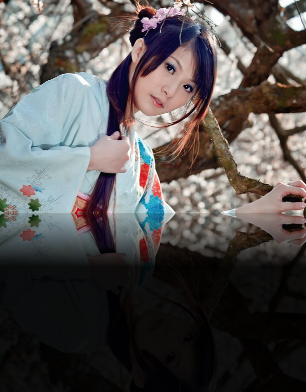倒影view和surfaceView的示例用法
2016-11-10 00:07
274 查看

倒影View 原理:
Matrix matrix = new Matrix();
matrix.setScale(1F, -1F);
public class ReflectView extends View {
private Bitmap mSrcBitmap, mRefBitmap;
private Paint mPaint;
private PorterDuffXfermode mXfermode;
public ReflectView(Context context) {
super(context);
initRes(context);
}
public ReflectView(Context context, AttributeSet attrs) {
super(context, attrs);
initRes(context);
}
public ReflectView(Context context, AttributeSet attrs,
int defStyleAttr) {
super(context, attrs, defStyleAttr);
initRes(context);
}
private void initRes(Context context) {
mSrcBitmap = BitmapFactory.decodeResource(getResources(),
R.drawable.test);
Matrix matrix = new Matrix();
matrix.setScale(1F, -1F);
mRefBitmap = Bitmap.createBitmap(mSrcBitmap, 0, 0,
mSrcBitmap.getWidth(), mSrcBitmap.getHeight(), matrix, true);
mPaint = new Paint();
mPaint.setShader(new LinearGradient(0, mSrcBitmap.getHeight(), 0,
mSrcBitmap.getHeight() + mSrcBitmap.getHeight() / 4,
0XDD000000, 0X10000000, Shader.TileMode.CLAMP));
mXfermode = new PorterDuffXfermode(PorterDuff.Mode.DST_IN);
}
@Override
protected void onDraw(Canvas canvas) {
canvas.drawColor(Color.BLACK);
canvas.drawBitmap(mSrcBitmap, 0, 0, null);
canvas.drawBitmap(mRefBitmap, 0, mSrcBitmap.getHeight(), null);
mPaint.setXfermode(mXfermode);
// 绘制渐变效果矩形
canvas.drawRect(0, mSrcBitmap.getHeight(),
mRefBitmap.getWidth(), mSrcBitmap.getHeight() * 2, mPaint);
mPaint.setXfermode(null);
}
}SurfaceView
在create方法中启动一个死循环draw 不停的绘制,拿画布的方式也比较特殊
public class SimpleDraw extends SurfaceView
implements SurfaceHolder.Callback, Runnable {
private SurfaceHolder mHolder;
private Canvas mCanvas;
private boolean mIsDrawing;
private Path mPath;
private Paint mPaint;
public SimpleDraw(Context context) {
super(context);
initView();
}
public SimpleDraw(Context context, AttributeSet attrs) {
super(context, attrs);
initView();
}
public SimpleDraw(Context context, AttributeSet attrs,
int defStyle) {
super(context, attrs, defStyle);
initView();
}
private void initView() {
mHolder = getHolder();
mHolder.addCallback(this);
setFocusable(true);
setFocusableInTouchMode(true);
this.setKeepScreenOn(true);
mPath = new Path();
mPaint = new Paint();
mPaint.setColor(Color.RED);
mPaint.setStyle(Paint.Style.STROKE);
mPaint.setStrokeWidth(40);
}
@Override
public void surfaceCreated(SurfaceHolder holder) {
mIsDrawing = true;
new Thread(this).start();
}
@Override
public void surfaceChanged(SurfaceHolder holder,
int format, int width, int height) {
}
@Override
public void surfaceDestroyed(SurfaceHolder holder) {
mIsDrawing = false;
}
@Override
public void run() {
long start = System.currentTimeMillis();
while (mIsDrawing) {
draw();
}
long end = System.currentTimeMillis();
// 50 - 100
if (end - start < 100) {
try {
Thread.sleep(100 - (end - start));
} catch (InterruptedException e) {
e.printStackTrace();
}
}
}
private void draw() {
try {
mCanvas = mHolder.lockCanvas();
mCanvas.drawColor(Color.WHITE);
mCanvas.drawPath(mPath, mPaint);
} catch (Exception e) {
} finally {
if (mCanvas != null)
mHolder.unlockCanvasAndPost(mCanvas);
}
}
@Override
public boolean onTouchEvent(MotionEvent event) {
int x = (int) event.getX();
int y = (int) event.getY();
switch (event.getAction()) {
case MotionEvent.ACTION_DOWN:
mPath.moveTo(x, y);
break;
case MotionEvent.ACTION_MOVE:
mPath.lineTo(x, y);
break;
case MotionEvent.ACTION_UP:
break;
}
return true;
}
}
相关文章推荐
- 倒影view和surfaceView的示例用法
- 倒影view和surfaceView的示例用法
- 倒影view和surfaceView的示例用法
- 倒影view和surfaceView的示例用法
- 倒影view和surfaceView的示例用法
- 倒影view和surfaceView的示例用法
- 倒影view和surfaceView的示例用法
- 倒影view和surfaceView的示例用法
- Android中SurfaceView用法示例
- android SurfaceView 使用示例 why SurfaceView上 不可以用控件的轻微解释
- Android SurfaceView游戏开发示例
- Android SurfaceView游戏开发示例
- Android SurfaceView学习示例
- CreateFileMapping 、MapViewOfFile、UnmapViewOfFile函数用法及示例
- Android SurfaceView游戏开发示例
- SurfaceView 典型用法
- Android SurfaceView学习示例
- UIScrollView的基本用法和简单示例
- Android里面使用MediaPlayer通过SurfaceView播放视频的示例
- 十四、SurfaceView用法
